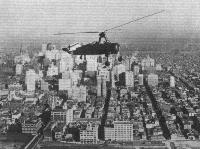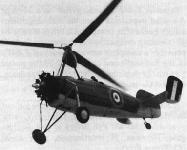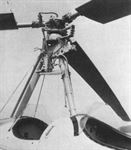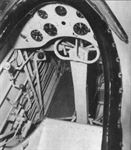
Описание
Страна : США
Год : 1935
Автожир
Two-seat observation direct-control autogiro
Pitcairn (Cierva). Автожиры
<...>
Затем был разработан PA-34 с приводом трехлопастного несущего винта, что позволило отказаться от фиксированного крыла.
<...>
- Описание
Фотографии
-
Aeroplane Monthly 1993-03 / H.Levy - Pitcairn's pinwheels (3)
Регистрационный номер: N3908 [14], BW830 [14] Robert Cooper's PA-39 N3908 pictured some years ago. It is currently owned by the EAA and has been restored to represent one of the RAF PA-39s, but is currently lacking its rotor blades.
-
Aeroplane Monthly 1993-03 / H.Levy - Pitcairn's pinwheels (3)
Регистрационный номер: BW830 [14], N3908 [14] Restored Pitcairn PA-39 painted to represent RAF aircraft BW830 (which was actually lost at sea on January 19, 1942), awaiting completion in Steve Pitcairn's hangar and pictured in February 1989.
-
Aeroplane Monthly 1993-06 / H.Levy - RAF Pitcairn
Регистрационный номер: BW830 [14], N3908 [14] The Autogiro is powered by a 175 h.p. Warner Super Scarab 165D seven-cylinder radial engine.
-
Aeroplane Monthly 1993-06 / H.Levy - RAF Pitcairn
Регистрационный номер: BW830 [14], N3908 [14] Pitcairn PA-39 BW830's first run-up for some 30 years.
-
Aeroplane Monthly 1993-06 / H.Levy - RAF Pitcairn
Регистрационный номер: BW830 [14], N3908 [14] A final view of the PA-39’s recent run-up. The rotor is unpowered in flight - it simply windmills - but a clutch system connected to the engine allows it to be run up to take-off speed while the aircraft is stationary on the ground.
-
Aeroplane Monthly 1993-06 / H.Levy - RAF Pitcairn
Регистрационный номер: BW830 [14], N3908 [14] Another view of owner Steve Pitcairn running-up the PA-39 recently, for the first time in 30 years.
-
Aeroplane Monthly 1993-06 / H.Levy - RAF Pitcairn
Регистрационный номер: BW830 [14], N3908 [14] The Pitcairn’s tail surfaces. The outward-canted tip fins utilise the rotor downwash to help counteract the propeller torque.
-
Aeroplane Monthly 1993-06 / H.Levy - RAF Pitcairn
Регистрационный номер: BW830 [14], N3908 [14] To compensate for the Autogiro’s high centre of gravity the engine has about 6° of downthrust.
-
Aeroplane Monthly 1993-06 / H.Levy - RAF Pitcairn
Регистрационный номер: BW830 [14], N3908 [14] The PA-39’s rotor head. Steve Pitcairn replaced the original rotor blades, which were destroyed in a landing accident in 1960, with units from a Piasecki HRP-1 helicopter. A set of 6 3/4 in-long extensions were specially manufactured to adapt the new blade-roots to the old hub.
-
Jane's All the World Aircraft 1938 / 03 - All the world's aeroplanes
The Pitcairn PA-33 (Army YG-2) Two-seat Observation Autogiro (420 h.p. Wright "Whirlwind" engine).
-
Flight 1935-11 / Flight
... PHILADELPHIA IN THE MORNING. This is the latest type of Autogiro to be delivered to the U.S. Army Air Corps, it is a product of the Pitcairn factory and has a Wright Whirlwind engine of 420 h.p., which is reported to give a maximum speed approaching 150 m.p.h. Here the machine is seen on a test flight prior to delivery at Wright Field, Dayton, Ohio, for official tests.
-
Aeroplane Monthly 1993-02 / H.Levy - Pitcairn's pinwheels (2)
The PA-33 (YG-2) observation Autogiro.
-
Jane's All the World Aircraft 1938 / 03 - All the world's aeroplanes
The Pitcairn PA-34 (Navy XOP-2) Two-seat Observation Autogiro (420 h.p. Wright "Whirlwind" engine).
-
Aeroplane Monthly 1993-03 / H.Levy - Pitcairn's pinwheels (3)
Регистрационный номер: BW833 PA-39 BW833 at Boscombe Down in December 1941. On November 19, 1942, it was damaged beyond repair.
-
Air Pictorial 1956-10
Регистрационный номер: BW829 [3] Rare photograph of the Pitcairn PA-39 Autogiro, BW-829.
-
Aeroplane Monthly 1993-03 / H.Levy - Pitcairn's pinwheels (3)
Регистрационный номер: BW829 [3] PA-39 BW829 at the factory in late 1941. It never arrived in Britain - along with two others, it was lost when the ship carrying it across the Atlantic was sunk by a U-boat in January 1942.
-
Aeroplane Monthly 1993-03 / H.Levy - Pitcairn's pinwheels (3)
Регистрационный номер: BW829 [3] RAF PA-39s immediately after assembly in late 1941.
-
Air International 1983-10
One of Pitcairn's autogiros, developed after Harold Pitcairn acquired the Cierva licence: a PA-39 for British evaluation in World War II.
-
Aeroplane Monthly 1993-03 / H.Levy - Pitcairn's pinwheels (3)
Регистрационный номер: N3908 [14], BW830 [14] Robert Cooper’s PA-39 N3908. The Autogiro is currently preserved by the EAA.
-
Aeroplane Monthly 1989-08 / M.Oakey - Grapevine
Регистрационный номер: BW830 [14], N3908 [14] In New Jersey, Steve Pitcairn has restored Pitcairn PA-39 autogiro BW830/N3908. Seven were built for the Royal Navy, five were shipped to the UK, three were lost on the way in U-boat attacks, and N3908 is believed to be the only survivor.
-
Aeroplane Monthly 1993-03 / H.Levy - Pitcairn's pinwheels (3)
Регистрационный номер: N3908 [14], BW830 [14] Pylon and rotor head of Robert Cooper’s PA-39 N3908
-
Aeroplane Monthly 1993-06 / H.Levy - RAF Pitcairn
Регистрационный номер: BW830 [14], N3908 [14] The PA-39’s cockpit has conventional-style main controls.
-
Aeroplane Monthly 1993-03 / H.Levy - Pitcairn's pinwheels (3)
Регистрационный номер: N3908 [14], BW830 [14] Cockpit of Robert Cooper’s PA-39 N3908
- Фотографии























